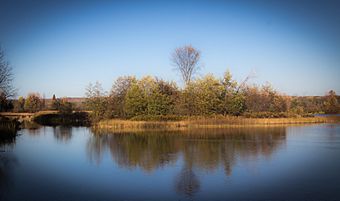Holtz Site facts for kids
|
Holtz Site
|
|
 |
|
| Nearest city | Bellaire, Michigan |
|---|---|
| Area | 25 acres (10 ha) |
| NRHP reference No. | 73002151 |
Quick facts for kids Significant dates |
|
| Added to NRHP | June 19, 1973 |
The Holtz Site, also known as 20AN26, is an exciting archaeological site located near Bellaire, Michigan. It sits on an island in the Intermediate River, surrounded by low, swampy areas. This special place gives us clues about people who lived here a long, long time ago!
Contents
Uncovering the Secrets of the Holtz Site
The Holtz Site is found in Michigan, close to the town of Bellaire, Michigan. It's on an island in the Intermediate River. This river is part of the larger Elk River Chain of Lakes. The area around the site is quite wet and swampy.
What Did Archaeologists Find?
In 1967, a team of researchers from Michigan State University began digging at the Holtz Site. They carefully uncovered many interesting things. These items are called artifacts. They help us understand the past.
The artifacts showed that the site was a temporary camp. It was used during a time known as the Middle Woodland period. This period was around 200 to 400 AD. That's about 1,600 to 1,800 years ago!
It seems people from southern Michigan traveled north. They likely stayed at the Holtz Site for a short time, perhaps for a season. They might have been hunting, fishing, or gathering food.
Why is the Holtz Site Important?
The Holtz Site is very important for understanding Michigan's history. Because of its historical value, it received special recognition. In 1970, it was named a Michigan State Historic Site. This means it's a place protected by the state.
Then, in 1973, it was added to the National Register of Historic Places. This is a list of places across the United States. These places are important for their history, architecture, or archaeology. Being on this list helps protect them for future generations.
Discoveries at the Holtz Site
During the excavations, archaeologists found five main features. These are areas or objects that show human activity. Each one tells a part of the story of the people who lived there:
- A small hearth: This was like a small fireplace. It measured about 1.4 by 1.5 feet. People would have used it for cooking or warmth.
- A concentration of potsherds: These are broken pieces of pottery. Finding many pieces in one spot suggests a place where pottery was used or stored.
- A modern fire pit: This shows that people used the site more recently too.
- Materials from hearth activities: These were things like charcoal or burnt stones. They were found near where a hearth might have been, even if the hearth itself wasn't clear.
- A second concentration of pottery: More broken pottery pieces were found in another area. This suggests different activity zones at the camp.



